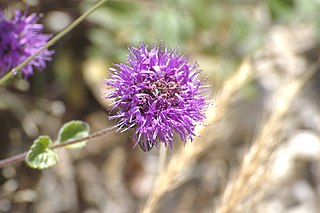
Eschscholzia californica, the California poppy, golden poppy, California sunlight or cup of gold, is a species of flowering plant in the family Papaveraceae, native to the United States and Mexico. It is cultivated as an ornamental plant flowering in summer, with showy cup-shaped flowers in brilliant shades of red, orange and yellow. It is also used as food or a garnish. It became the official state flower of California in 1903.

In botany, a peduncle is a stalk supporting an inflorescence or a solitary flower, or, after fecundation, an infructescence or a solitary fruit. The peduncle sometimes has bracts at nodes. The main axis of an inflorescence above the peduncle is the rachis. There are no flowers on the peduncle but there are flowers on the rachis.

Lepechinia fragrans is a flowering herbaceous shrub known by the common names island pitchersage and fragrant pitchersage. It is a member of the Lamiaceae, or mint family, but like other Lepechinia, the flowers are borne in racemes instead of in mintlike whorls.

Oemleria cerasiformis, a shrub commonly known as osoberry or Indian plum, is the sole species in genus Oemleria.

Coreopsis maritima, the sea dahlia, is a species of tickseed in the sunflower family.

Dudleya traskiae is a rare succulent plant known by the common name Santa Barbara Island liveforever. This Dudleya is endemic to Santa Barbara Island, one of the Channel Islands of California, where it grows on rocky bluffs. The plant has a basal rosette of flat, spade-shaped fleshy leaves up to 15 centimeters long, which are pale green to yellowish. It erects tall stems bearing dense, rounded inflorescences of many bright yellow flowers.

Eriophyllum confertiflorum, commonly called golden yarrow or yellow yarrow, is a North American species of plant in the family Asteraceae, native to California and Baja California. It has wooly leaves when young, and yellow flower heads. "Eriophyllum" means "wooly leaved."

Fritillaria ojaiensis is a rare species of fritillary known by the common name Ojai fritillary.

Heterotheca sessiliflora is a species of flowering plant in the family Asteraceae known by the common name sessileflower false goldenaster. It is native to California, Sonora, and Baja California.
Caulanthus californicus is a species of flowering plant in the family Brassicaceae known by the common names California jewelflower and St. Francis cabbage.

Lysimachia latifolia, sometimes called Trientalis latifolia, is a species of flowering plant in the family Primulaceae. It is known as starflower, chickweed-wintergreen, or Pacific starflower.

Dendrobium gracilicaule, commonly known as the blotched cane orchid or yellow cane orchid, is an epiphytic or lithophytic orchid in the family Orchidaceae. It has cylindrical pseudobulbs, between three and seven thin leaves and up to thirty often drooping, cream-coloured to yellow or greenish flowers, sometimes with reddish brown blotches on the back. There are two varieties, one occurring in Queensland and New South Wales and the other on some Pacific Islands, including Lord Howe Island.

Monardella undulata is an uncommon species of flowering plant in the mint family known by the common name curlyleaf monardella. It is an annual herb and is endemic to the coast of California.

Ribes sericeum is a species of currant known by the common name Lucia gooseberry, or Santa Lucia gooseberry; its Latin epithet of sericeum means "of silk". It is endemic to California, where it is known only from the Santa Lucia Mountains along the Central Coast and an additional isolated population in Santa Barbara County.

Sherwin John Carlquist FMLS was an American botanist and photographer.

Veronica perfoliata, commonly known as digger's speedwell, is a common perennial herb found at higher altitudes in south-eastern Australia. It is a low-growing multi-stemmed plant rising from a woody rootstock. It has rounded blue-grey foliage and sprays of intense violet-blue flowers at the end of arching branches. It is occasionally cultivated as a garden plant.

Calochortus fimbriatus is a California species of flowering plant in the lily family known by the common name late-blooming mariposa lily. It is native to the coastal mountain ranges of southern Monterey, San Luis Obispo, Santa Barbara and northern Ventura counties, where it is a member of the chaparral flora.

Sara Allen Plummer was an American botanist and the wife of California botanist John Gill Lemmon. Mount Lemmon in Arizona is named for her, as she was the first white woman to ascend it. She was responsible for the designation of the golden poppy as the state flower of California, in 1903. A number of plants are also named in her honor, including the new genus Plummera, described by Harvard University botanist Asa Gray in 1882.
Shirley Cotter Tucker is an American botanist, lichenologist, and a former Boyd Professor of botany at Louisiana State University. The standard author abbreviation S.C.Tucker is used to indicate this person as the author when citing a botanical name.

Glandularia lilacina is a species of flowering plant in the verbena family known by the common name Cedros Island verbena. It is native to Cedros Island and the adjacent Baja California coast. It is a perennial herb growing to 3 feet tall by 3 feet wide, with erect stems, narrow and elongate bipinnatifid leaves. The plant is available in multiple cultivars for gardens.

















